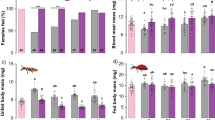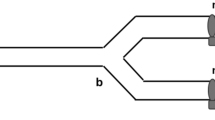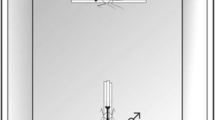Abstract
This study investigates whether female sequential decisions on accepting or rejecting a courting male are based exclusively on the quality of the male present or are affected by the quality of potential mates. We used blood-sucking bugs Rhodnius prolixus as experimental subjects as females’ exhibit stereotyped discrimination behavior towards undesirable males, which allows sequential testing of a female’s preference for each male. We expect higher levels of female rejection when the benefit of finding a better quality male overrides the cost of rejecting a mating opportunity. Male quality was manipulated through changes in the feeding regime prior to the experiment because in this species nutritional condition affects males’ reproductive success. Females were simultaneously exposed to both a focal male currently available and a background male potentially available. The quality of each focal and background male could be either low or high and all the possible combinations were tested for each pair (low/high, high/low, high/high, low/low). We found that female rejection behavior depends not only on the quality of the focal male but also on the quality of the background male. This behavioral flexibility may allow females to maximize the benefits of their mating decisions.
Significance statement
Using an experimental approach, we study how females of a blood-sucking bug assess male quality and decide whether to accept or reject a mating opportunity in a sequential choice paradigm. Male quality (high/low) and male availability (current/potential) were manipulated. We show that female rejection depends on both the quality of the current and potential mates. Female rejection increases when better quality males are potentially available. This behavioral flexibility may allow females to maximize the benefits of mating decisions.



Similar content being viewed by others
References
Abdel-Azim MM, Aldosari SA, Shukla P (2018) Factors influencing mating behavior and success in the red palm weevil, Rhynchophorus ferrugineus Olivier (Coleoptera: Dryophthoridae). Neotrop Entomol. https://doi.org/10.1007/s13744-018-0592-9
Aluja M, Rull J, Sivinski J, Trujillo G, Pérez-Staples D (2009) Male and female condition influence mating performance and sexual receptivity in two tropical fruit flies (Diptera: Tephritidae) with contrasting life histories. J Insect Physiol 55:1091–1098
Andersson MB (1994) Sexual selection. Princeton University Press, Princeton, New Jersey
Andrade MCB, Mason AC (2000) Male condition, female choice, and extreme variation in repeated mating in a scaly cricket, Ornebius aperta (Orthoptera: Gryllidae: Mogoplistinae). J Insect Behav 13:483–497
Atwell A, Wagner WE (2014) Female mate choice plasticity is affected by the interaction between male density and female age in a field cricket. Anim Behav 98:177–183
Bakker TCM, Milinski M (1991) Sequential female choice and the previous male effect in sticklebacks. Behav Ecol Sociobiol 29:205–210
Bateman PW, Gilson LN, Ferguson JWH (2001) Male size and sequential mate preference in the cricket Gryllus bimaculatus. Anim Behav 61:631–637
Berglund A (1995) Many mates make male pipefish choosy. Behaviour 131:213–218
Berglund A, Widemo MS, Rosenqvist G (2005) Sex-role reversal revisited: choosy females and ornamented, competitive males in a pipefish. Behav Ecol 16:649–655
Bleu J, Bessa-Gomes C, Laloia D (2012) Evolution of female choosiness and mating frequency: effects of mating cost, density and sex ratio. Anim Behav 83:131–136
Bonduriansky R (2001) The evolution of male mate choice in insects: a synthesis of ideas and evidence. Biol Rev 76:305–339
Bonduriansky R, Mallet MA, Arbuthnott D, Pawlowsky-Glahn V, Egozcue JJ, Rundle HD (2015) Differential effects of genetic vs. environmental quality in Drosophila melanogaster suggest multiple forms of condition dependence. Ecol Lett. https://doi.org/10.1111/ele.12412
Cardoso Giaquinto P, da Silva Berbert CM, Delicio HC (2010) Female preferences based on male nutritional chemical traits. Behav Ecol Sociobiol 64:1029–1035
Cotton S, Fowler K, Pomiankowski A (2004) Do sexual ornaments demonstrate heightened condition-dependent expression as predicted by the handicap hypothesis? Proc R Soc Lond B 271:771–783
Crespo JG, Manrique G (2007) Mating behavior of the haematophagous bug Triatoma infestans: role of Brindley’s and metasternal glands. J Insect Physiol 53:708–714
Crowley PH, Travers SE, Linton MC, Cohn SL, Sih A, Craig Sargent R (1991) Mate density, predation risk, and the seasonal sequence of mate choices: a dynamic game. Am Nat 137:567–596
De Simone GA (2018) Factores y reglas de decisión involucrados en la elección de pareja sexual en el insecto hematófago Rhodnius prolixus (Hemiptera: Reduviidae). Dissertation (Ph D. Thesis), Universidad de Buenos Aires
Fricke C, Bretman A, Chapman T (2008) Adult male nutrition and reproductive success in Drosophila melanogaster. Evolution 62:3170–3177
Friend W, Choy C, Cartwright E (1965) The effect of nutrient intake on the development and the egg production of Rhodnius prolixus Stål (Hemiptera: Reduviidae). Can J Zool 43:891–904
Gabor CR, Halliday TR (1997) Sequential mate choice by multiply mating smooth newts: females become more choosy. Behav Ecol 8:162–166
Goodchild AJP (1955) Some observations on growth and egg production of the blood-sucking Reduviids, Rhodnius prolixus and Triatoma infestans. Physiol Entomol 30:137–144
Griggio M, Hoi H, Lukasch B, Pilastro A (2016) Context-dependent female preference for multiple ornaments in the bearded reedling. Ecol Evol 6:493–501
Hebets EA (2003) Subadult experience influences adult mate choice in an arthropod: exposed female wolf spiders prefer males of a familiar phenotype. PNAS 100:13393
Janetos AC (1980) Strategies of female mate choice: a theoretical analysis. Behav Ecol Sociobiol 7:107–112
Jennions MD, Petrie M (1997) Variation in mate choice and mating preferences: a review of causes and consequences. Biol Rev 72:283–327
Kahrl AF, Cox RM (2015) Diet affects ejaculate traits in a lizard with condition-dependent fertilization success. Behav Ecol 26:1502–1511
Khalifa A (1950) Spermatophore production and egg-laying behaviour in Rhodnius prolixus Stål (Hemiptera; Reduviidae). Parasitology 40:283–289
Kudo H, Karino K (2012) Short-term change in male sexually selected traits and female mate preference in the guppy Poecilia reticulate. Ichthyol Res 59:1–7
Lazzari CR (1992) Circadian organization of locomotion activity in the haematophagous bug Triatoma infestans. J Insect Physiol 38:895–903
Locatello L, Poli F, Rasotto MB (2015) Context-dependent evaluation of prospective mates in a fish. Behav Ecol Sociobiol 69:1119–1126
Manrique G, Lazzari CR (1994) Sexual behaviour and stridulation during mating in Triatoma infestans (Hemiptera: Reduviidae). Mem Inst Oswaldo Cruz 89:629–633
Manrique G, Lazzari CR (1995) Existence of a sex pheromone in Triatoma infestans (Hemiptera: Reduviidae): I. Behavioural evidences. Mem Inst Oswaldo Cruz 90:645–648
Manrique G, Vitta ACR, Ferreira RA, Zani CL, Unelius CR, Lazzari CR, Diotaiuti L, Lorenzo MG (2006) Chemical communication in Chagas disease vectors. Source, identity and potential function of volatiles released by the metasternal and Brindley’s glands of Triatoma infestans adults. J Chem Ecol 32:2035–2052
Murphy CG, Gerhardt HC (2002) Mate sampling by female barking treefrogs (Hyla gratiosa). Behav Ecol 13:472–480
Neelon DP, Höbel G (2017) Social plasticity in choosiness in green tree frogs, Hyla cinerea. Behav Ecol 28:1540–1546
Pires HHR, Lorenzo MG, Lazzari CR, Diotaiuti L, Manrique G (2004) The sexual behaviour of Panstrongylus megistus (Hemiptera: Reduviidae): an experimental study. Mem Inst Oswaldo Cruz 99:295–300
Pitcher TE, Neff BD, Rodd FH, Locke R (2003) Multiple mating and sequential mate choice in guppies: females trade up. Proc R Soc B Biol Sci 270:1623–1629. https://doi.org/10.1098/rspb.2002.2280
Pompilio L, González Franco M, Chisari LB, Manrique G (2016) Female choosiness and mating opportunities in the blood-sucking bug Rhodnius prolixus. Behaviour 153:1863–1878
Pontes GB, Lorenzo MG (2012) Female metasternal gland odours mediate male aggregation in Rhodnius prolixus, a triatomid bug. Med Vet Entomol 26:33–36
Poulin R, Vickery WL (1996) Parasite-mediated sexual selection: just how choosy are parasitized females? Behav Ecol Sociobiol 38:43–49
Real LA (1990) Search theory and mate choice. I. Models of single-sex discrimination. Am Nat 136:376–405
Real LA (1991) Animal choice behavior and the evolution of cognitive architecture. Science 253:980–986
Reaney T (2009) Female preference for male phenotypic traits in a fiddler crab: do females use absolute or comparative evaluation? Anim Behav 7:139–143
Roces F, Manrique G (1996) Different stridulatory vibrations during sexual behaviour and disturbance in the blood-sucking bug Triatoma infestans (Hemiptera: Reduviidae). J Insect Physiol 42:231–238
Schäfer MA, Uhl G (2005) Sequential mate encounters: female but not male body size influences female remating behavior. Behav Ecol 16:461–466
Shelly TE, Bailey WJ (1992) Experimental manipulation of mate choice by male katydids: the effect of female encounter rate. Behav Ecol Sociobiol 30:277–282
Vitta ACR, Lorenzo MG (2009) Copulation and mate guarding behavior in Triatoma brasiliensis (Hemiptera: Reduviidae). J Med Entomol 46:789–795
Wagner WE Jr, Smeds MR, Wiegmann DD (2001) Experience affects female responses to male song in the variable field cricket Gryllus lineaticeps (Orthoptera, Gryllidae). Ethol 107:769–776
Wiegmann DD, Angeloni LM, Seubert SM, Wade JG (2013) Mate choice decisions by searchers. Curr Zool 59:184–199
Willis PM, Ryan MJ, Rosenthal GG (2011) Encounter rates with conspecific males influence female mate choice in a naturally hybridizing fish. Behav Ecol 22:1234–1240
Wittenberger JF (1983) Tactics of mate choice. In: Bateson P (ed) Mate choice. Cambridge University Press, New York, pp 435–447
Xie J, De Clercq P, Zhang Y, Wu H, Pan C, Pangb H (2015) Nutrition-dependent phenotypes affect sexual selection in a ladybird. Sci Rep 7:159–170
Zahavi A (1975) Mate selection-a selection for a handicap. J Theor Biol 53:205–214
Acknowledgments
The authors are grateful to Dr. Gerardo Cueto, Facultad de Ciencias Exactas y Naturales, Departamento de Ecología Genética y Evolución and IEGEBA, CONICET-UBA, Universidad de Buenos Aires, for statistical advice.
Funding
This work was supported by Consejo Nacional de Investigaciones Científicas y Técnicas (CONICET) and Universidad de Buenos Aires, Facultad de Ciencias Exactas y Naturales, Departamento de Biodiversidad y Biología Experimental, Programación Científica 2014-2017 (20020130100341BA).
Author information
Authors and Affiliations
Corresponding authors
Ethics declarations
Conflict of interest
The authors declare that they have no conflict of interest.
Ethical approval
We did not observe any harmful effects associated to our experimental manipulation. At the end of the experiment, the insects were returned to their breeding cages and the hens to the chicken coop. All animals were handled according to the biosafety rules from the Servicio de Higiene y Seguridad of the Facultad de Ciencias Exactas y Naturales, Universidad de Buenos Aires, Argentina.
Informed consent
Not applicable.
Additional information
Communicated by S. Sakaluk
Rights and permissions
About this article
Cite this article
De Simone, G.A., Manrique, G. & Pompilio, L. Females’ sequential mating decisions depend on both the quality of the courting male and the quality of the potential mates in a blood-sucking bug. Behav Ecol Sociobiol 72, 145 (2018). https://doi.org/10.1007/s00265-018-2560-0
Received:
Revised:
Accepted:
Published:
DOI: https://doi.org/10.1007/s00265-018-2560-0




